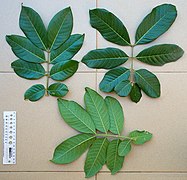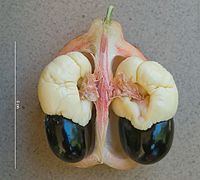Ackee
| Ackee | |
|---|---|

| |
| Fruit | |
| Scientific classification | |
| Kingdom: | Plantae |
| Clade: | Tracheophytes |
| Clade: | Angiosperms |
| Clade: | Eudicots |
| Clade: | Rosids |
| Order: | Sapindales |
| Family: | Sapindaceae |
| Genus: | Blighia |
| Species: | B. sapida
|
| Binomial name | |
| Blighia sapida | |
| Synonyms | |
|
Cupania sapida Voigt | |
| Nutritional value per 100 g (3.5 oz) | |
|---|---|
9.55 g | |
| Dietary fiber | 3.45 g |
18.78 g | |
8.75 g | |
Niacin (B3) | 23% 3.74 mg |
| Vitamin C | 72% 65 mg |
| Minerals | Quantity %DV† |
| Calcium | 6% 83 mg |
| Iron | 31% 5.52 mg |
| Phosphorus | 8% 98 mg |
Raw arils after pods allowed to open naturally. Seeds removed | |
| †Percentages estimated using US recommendations for adults,[3] except for potassium, which is estimated based on expert recommendation from the National Academies.[4] | |
The ackee (Blighia sapida), also known as acki, akee, or ackee apple, is a fruit of the
Although having a long-held reputation as being poisonous with potential fatalities,[7] the fruit arils are renowned as delicious when ripe, prepared properly, and cooked[8] and are a feature of various Caribbean cuisines.[2] Ackee is the national fruit of Jamaica and is considered a delicacy.[8]
Botany
Ackee is an
The fruit is pear-shaped and has three lobes (two to four lobes are common).[12] When it ripens it turns from green to a bright red to yellow-orange and splits open to reveal three large, shiny black seeds, each partly surrounded by soft, creamy or spongy, white to yellow flesh — the aril having a nut-like flavor and texture of scrambled eggs.[2][9] The fruit typically weighs 100–200 grams (3.5–7.1 oz).[9] The tree can produce fruit throughout the year, although January–March and October–November are typically periods of fruit production.[12]
-
Leaves, upper and lower surface
-
Fruit as it splits upon ripening "smile"
-
Showing ripe fruit and seeds with their arils
-
Part of ripe fruit, two seeds with their arils still attached
-
Ripe seeds with their arils (dorsal view and in longitudinal section)
Cultivars
There are up to as many as forty-eight cultivars of ackee, which are grouped into either "butter" or "cheese" types.[13] The cheese type is pale yellow in color and is more robust and finds use in the canning industry. The butter type is deeper yellow in color, and is more delicate and better suited for certain cuisine.[13]
History and culinary use

Imported to Jamaica from West Africa before 1773,[2][14] the use of ackee in Jamaican cuisine is prominent. Ackee is the national fruit of Jamaica,[8] whilst ackee and saltfish is the official national dish of Jamaica.[15]
The ackee is allowed to open fully before picking in order to eliminate toxicity. When it has "yawned" or "smiled", the seeds are discarded and the fresh, firm arils are
Nutrition
Ackee contains a moderate amount of carbohydrates, protein, and fat,[2] providing 51–58% of the dry weight of the arils as composed of fatty acids – linoleic, palmitic, and stearic acids.[16] The raw fruit is a rich source of vitamin C.[2]
Society and culture
The ackee is prominently featured in the Jamaican mento style folksong "Linstead Market". In the song, a market seller laments, "Carry mi ackee go a Linstead market. Not a quattie worth sell".[17] The Beat's 1982 album Special Beat Service includes the song "Ackee 1-2-3".[18]
Saltfish 'n Ackee is the preferred breakfast of
]Toxicity

The unripened aril and the inedible portions of the fruit contain hypoglycin toxins including hypoglycin A and hypoglycin B, known as "soapberry toxins".[7][19] Hypoglycin A is found in both the seeds and the arils, while hypoglycin B is found only in the seeds.[9] Minimal quantities of the toxin are found in the ripe arils.[20] In the unripe fruit, depending on the season and exposure to the sun, the concentrations may be up to 10 to 100 times greater.[20]
These two molecules are converted in the body to
Though ackee is used widely in traditional dishes, research on its potential hypoglycin toxicity has been sparse and preliminary, requiring evaluation in well-designed clinical research to better understand its pharmacology, food uses, and methods for detoxification.[24]
In 2011, it was found that as the fruit ripens, the seeds act as a sink whereby the hypoglycin A in the arils convert to hypoglycin B in the seeds.[25] In other words, the seeds help in detoxifying the arils, bring the concentration of hypoglycin A to a level which is generally safe for consumption.[26]
Commercial use
Ackee canned in brine is a commodity item and is used for export by Jamaica, Haiti and Belize.[27] If propagated by seed, trees will begin to fruit in 3–4 years. Cuttings may yield fruit in 1–2 years.[27][13]
Other uses
The fruit has various uses in West Africa and in rural areas of the Caribbean Islands, including use of its "soap" properties as a laundering agent or fish poison.
Vernacular names in African languages
| Language | Word | Meaning |
|---|---|---|
| Bambara | finsan | akee apple |
| Kabiye | kpɩ́zʋ̀ʋ̀ | akee apple |
| Yoruba | iṣin[28] | |
| Dagaare | kyira | |
| Ewe | atsa |
References
- ^ IUCN SSC Global Tree Specialist Group & Botanic Gardens Conservation International (BGCI) (2019). "Blighia sapida". IUCN Red List of Threatened Species. 2019: e.T146420481A156104704. Retrieved 2 January 2022.
- ^ a b c d e f g h i j k l m n o p q Morton, JF (1987). "Ackee; Blighia sapida K. Konig". Fruits of warm climates. Miami, FL: The Center for New Crops and Plant Products, at Purdue University. pp. 269–271. Retrieved 3 May 2019.
- ^ United States Food and Drug Administration (2024). "Daily Value on the Nutrition and Supplement Facts Labels". Retrieved 28 March 2024.
- )
- ^ "Blighia sapida". Germplasm Resources Information Network. Agricultural Research Service, United States Department of Agriculture. Retrieved 18 October 2011.
- ISBN 0-395-95920-9.
- ^ PMID 27367968.
- ^ a b c "Ackee". Jamaican Information Service. 2019. Retrieved 3 May 2019.
- ^ ISBN 0-444-81284-9.
- ISBN 0-88192-585-3.
- ISBN 0-88192-422-9.
- ^ OCLC 910662541. [page needed]
- ^ S2CID 195661482.
- ^ "This is Jamaica". National Symbols of Jamaica. Archived from the original on 19 June 2006. Retrieved 4 June 2006.
- ^ "Top 10 National Dishes". National Geographic Traveller. 13 September 2011. Archived from the original on 24 September 2011. Retrieved 19 August 2016.
- ^ "Jamaican Ackee". wwwchem.uwimona.edu.jm. Retrieved 17 July 2020.
- ^ "Ackee - Jamaican National Symbol". Jamaica Information Service. Retrieved 16 July 2020.
- ^ "Ackee 1 2 3 - The English Beat". Allmusic.com. Retrieved 18 June 2022.
- ^ PMID 26328472.
- ^ ISBN 978-0-12-387817-5, retrieved 5 July 2020
- ISBN 978-0-7020-2579-2.
- ISBN 0-8247-4093-9.
- Science Creative Quarterly.
- S2CID 195661482.
- PMID 21410289.
- PMID 16099087.
- ^ ISBN 978-0-12-800605-4, retrieved 27 June 2020
- S2CID 149837516.
External links
- Blighia sapida in West African plants – A Photo Guide.
- Ackee and saltfish: Jamaica's breakfast of champions – BBC Travel







